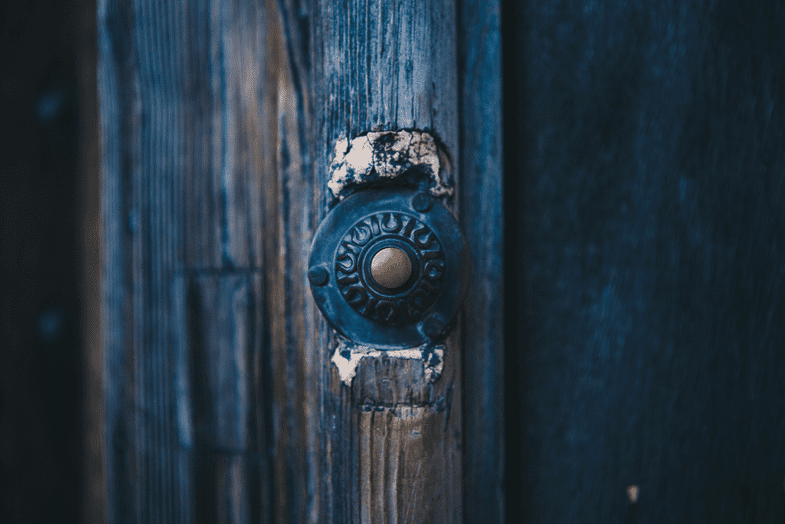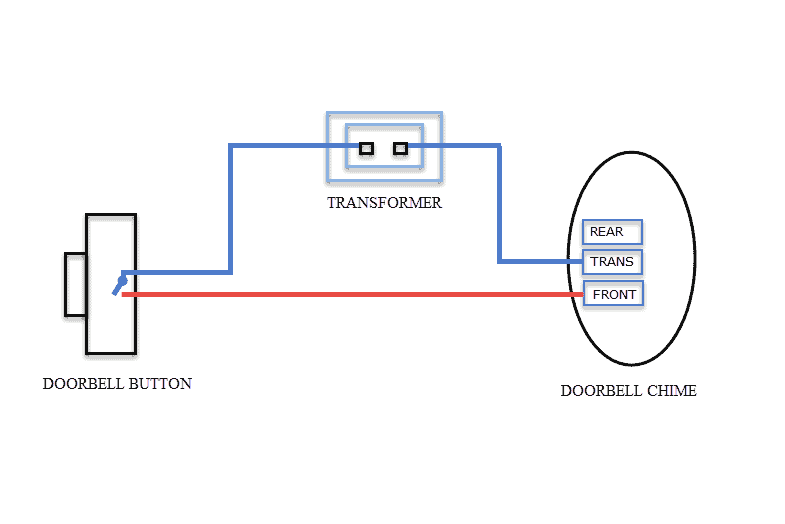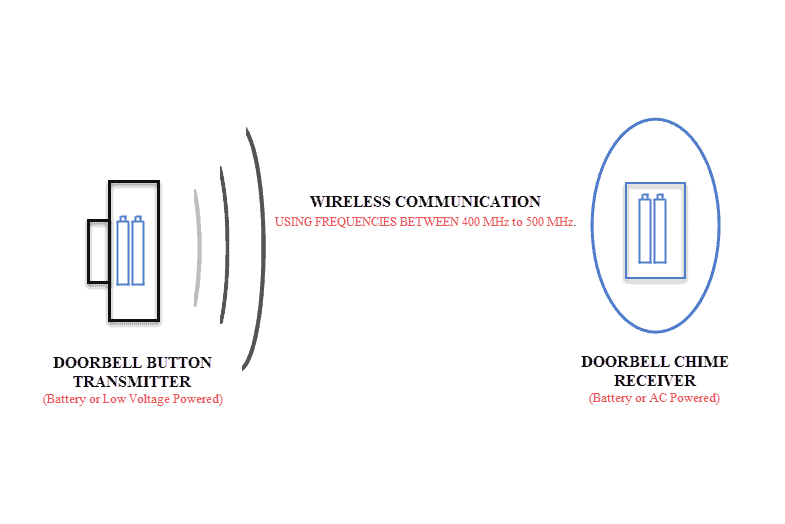can i change my ring doorbell chime

I was working from home the other day when the doorbell rang. To my surprise, no ane was at that place when I opened the door. Later that evening, it rang again, and again, no one was there! I wondered, tin a doorbell band past itself? So I did some inquiry to find out and this is what I institute.
And so can a doorbell ring past itself? A doorbell, whether wired or wireless, can band past itself. Wired doorbells commonly ring on their own due to wiring shorts. Wireless doorbells can ring by themselves due to sensor contact or signal frequency interference.
Equally information technology turns out, your doorbell can ring by itself whether information technology'south high tech or the original doorbell ever created!
When the doorbell rings, yous expect to observe someone at the door. And, if your family is anything like ours when the doorbell rings, classical conditioning takes over (Pavlov's Classical Workout) and you lot immediately imagine a savory Amazon package simply waiting to be picked up!
Normally, when the doorbell rings and no one (person or package) is in that location, you retrieve information technology'southward the neighbor kids playing ding dong ditch, and not that your doorbell is malfunctioning.
Despite your initial cess, y'all can take comfort in the fact that this is a common issue yous can hands fix.
How a Doorbell Rings by Itself
In general, a wired doorbell can past itself due to grit, shorts, or improper installation. If you lot're similar near people, and so you lot don't really think near needing to maintain your doorbell.
However, equally your abode (and doorbell) ages, wear and tear occur on all systems including wiring. And just like a car, homes (including doorbells) crave some maintenance to brand them final.
Unfortunately, doorbells are often an ignored home feature until it rings on its own in the eye of the night or you go along missing deliveries or visitors because you did not hear information technology.
My research showed that wiring or point issues are the main cause of doorbell misfires.
Reasons, why a doorbell stops working, are numerous, merely why a doorbell may band on its ain boils down to the following:
- A sticking button (wired and wireless Doorbells)
- Wiring short ( wired Doorbells)
- A Frequency interference ( wireless Doorbells)
How to Set up Doorbell – Sticking Doorbell Push button
Your DIY authority volition ascent when you acquire how to fix the doorbell ghost problem. At least, with your married woman or family unit.
To fix a sticking doorbell button, you simply demand to make clean the area where the button sits and slides when pressed to make contact.
The problem of "ringing on its own" is unremarkably because the push is continuously making contact with the sensor. Clay and dust accumulation are the usual reasons why a doorbell push sticks and does not slide back into place.
A small-scale gap betwixt the contacts can develop electrostatic charges that tin can discharge with vibrations, moisture or by having plenty charge to jump the gap between contacts, leading to false alerts.
If a doorbell ringing on its ain continues to exist an upshot, so regular maintenance is due.
To address the issue, you'll demand (in most cases) simple tools like:
- Screwdriver
- Needlenose pliers
- WD-40
- Vacuum
- Compressed air (compressor or co2 tin)
Fixing a Stuck Doorbell Push button:
- Unscrew the doorbell from the wall
- Carefully remove the button from the casing
- Expect for dirt or grit accumulation around the button and between the push button and push housing
- Thoroughly clean effectually the button and doorbell housing
- Accident compressed air to remove all clay and debris in areas not accessible through normal means without causing damage to the doorbell.
DIY TIP
If y'all want to keep the doorbell ghosts at bay, spray a petty WD-xl between the bottom and button housing. This will extend the time between maintenance intervals. IMPORTANT – Practice NOT overspray equally this will cause accumulation of liquid which can then concenter dirt and dust leading to increased maintenance.
INSERT Pictures Here
Insert DIY Video Link Here
Fixing a Wired Doorbell
If you have a wired doorbell and a stuck button is not the issue, but it intermittently continues to ring on its own, so in that location you take a wiring short, a loose wire, or both! Otherwise, if your doorbell were to have any other problems, it would stop working altogether.
Fixing a wire curt tin can be an easy DIY task with the right tools and a trivial know-how.
Initial Troubleshooting – Inspect The Doorbell
Begin past removing the doorbell button from the wall and inspect the contacts and wires connecting to it. If your wires are exposed or y'all can visibly meet "night" burnt markings or smoke stains, then chances are, you have a wire brusque.
Fix the short past making sure all wire connections are tight and add electrical tape to foreclose exposed wires from touching. Most of the time, this simple DIY fix will solve your doorbell push wire shorting bug.
Nonetheless, sometimes the upshot could be beyond your doorbell button. Read on to find out why…
Deeper Troubleshooting – Follow the Doorbell Wiring
If your doorbell push button appears normal and is void of any spark marks or visible electrical short bug, and so the trouble could lie within the wiring that connects the doorbell button to the transformer or the doorbell chinkle.
Hither's a simplified doorbell wiring diagram:

And then how do doorbells work?
In simple terms, a wired doorbell has three components to brand a circuit loop:
- A doorbell button/switch
- A transformer, and
- A chime.
The transformer is typically hard-wired to the home's electrical system and steps downwardly the 120-volt house circuit to the right voltage and wattage required past your doorbell. Near transformers connect to the doorbell push button with one wire, and to the doorbell chinkle, with another.
The doorbell chime is what makes the ring sound. Most chimes have REAR, TRANS, and FRONT terminals. The FRONT and REAR terminals are used for, you lot guess it, doorbell buttons at the front end or the rear of the home. The TRANS terminal is connected to the transformer which provides a low voltage power source.
When the doorbell button is pressed, the otherwise open circuit closes, and a surge of low voltage flows from the transformer to the chime, causing it to ring.
Check out our " How Does a Doorbell Work? " commodity for additional details.
" commodity for additional details.
If you've determined that your short could exist in the wires connecting the doorbell button to the transformer or doorbell chime, then you basically take two options:
- Follow the wires to find the short and, depending on where you live and style of your home, it might include crawling through your cranium or crawlspace.
- Or, say the heck with it, and purchase your self a new wireless doorbell!
If you're a true DIY'er, or like me, just stubborn, and chose to tackle this wiring issue, y'all will demand a couple of tools to get the job washed:
- Knife
- Wire Cutter / Stripper
- Electrical Record
- Wire Caps
- Extra Doorbell Wire (18 gauge)
If yous're 1 of the lucky few who tin can easily access the wires connecting your doorbell push button to the chime or transformer, then this volition be cake:
- First and nearly Of import, plough off the electricity powering the transformer at the electrical panel! Though low voltage, you can still get shocked if a more serve house wiring effect is present, don't run a risk information technology.
- Visibly audit the wires for exposed areas or signs of an electric curt. Look for burnt or discolored areas. Sometimes a nail or screw can harm the wiring and lead to a short.
- When you lot detect the short, cut out the slice of the wire causing the short using your wire cutters and or knife. The length of wire yous remove should be equally long equally you lot feel the issue is visible.
- Complete the wire connections using the new doorbell wire and wire caps
- Use electrical record as needed to seal the cutting wire area for added protection
Piece of cake peasy! Well, maybe… And so what if your wires are non the issue? Then y'all're down to the transformer or the chime. But as mentioned before, if your doorbell is ringing, even if on its own, and so chances are your transformer and chinkle are working. Otherwise, you would not hear it at all.
Check out our " How to Test a Doorbell Transforme r
r " article for additional details.
" article for additional details.
When all else fails and you simply don't have access to your doorbell's wiring, replacing your one-time doorbell ready up with a new, wireless system, is not cost prohibited.
When we remodeled our home, we realized the old doorbell set upwardly would no longer work with our pattern and, opted to buy a new wireless system for about the same toll of running new wire and replacing the transformers.
The options were many, but nosotros took the time and reviewed several models and ended upward going with the Ring Doorbell. However, not all homes are the same and not everyone wants a smart doorbell. I recommend doing a fiddling research of your own.
Cheque out our Tiptop 10 All-time Wireless Doorbells article, to salvage yous some time and help you chose the best doorbell for your situation.
article, to salvage yous some time and help you chose the best doorbell for your situation.
Fixing a Wireless Doorbell – Changing Frequencies
If yous own a wireless doorbell, know that they are not perfect and can still malfunction. However, if the event is that it rings by itself, then the gear up is usually a pretty like shooting fish in a barrel DIY task.
Most self-reigning issues with wireless doorbells are caused by frequency bespeak interference.
Heres a simplified wireless doorbell diagram

To understand the set, you first need to understand how your wireless doorbell functions.
Wireless doorbells function using a frequency range betwixt 400MHz and 500 MHZ. A wireless doorbell button is either battery or low voltage powered and contains a transmitter, that when pressed, sends a signal at a fix frequency.
Equally long every bit the doorbell chime receiver recognizes the betoken from the transmitter, advice is established and the doorbell will ring.
The problem happens when other nearby wireless devices using the same frequency.
The FCC only allows certain "usable" frequency bands available for public use, and specific wireless devices have to operate inside a specific frequency range.
As mentioned, most manufacturers use the 400MHz to 500MHz bands for their doorbell frequency range. The actual communications between the ii devices occur on sub-frequencies (or channels) inside the given frequency band. If two close-by products are operating on the same frequency, interference may occur.
This can occur when your neighbour's garage opener is set to the aforementioned frequency as your wireless doorbell, or when a babe monitor picks up people talking on their wireless home telephone. Scary, right?
So, how do you gear up a self-ringing wireless doorbell? You change the frequency. Most wireless units let you to alter the frequency or privacy code by selecting sub-frequencies. The instructions material that came with your device should provide device-specific instructions on how to change your doorbell's privacy code.
What is a wireless Doorbell Privacy Code?
Nearly wireless doorbells today have what are called "privacy codes" or channel selectors. Privacy codes provide the power to dial in the operating frequency of the wireless doorbell within a given range to include sub-frequencies.
For instance, by changing the privacy code, instead of sending a bespeak at 425MHz, the transmitter sends a indicate at 425.5 MHz. When both the transmitter and the receiver take the same privacy codes, the two components operate at exactly the same frequency and, the likelihood of another device operating at 425.5 MHz is slim.
Privacy codes are often located on the back of the receiver and on the back of the doorbell transmitter. This is usually just a small-scale button or slide on the side of your doorbell or receiver. To change the privacy lawmaking you simply slide the buttons to the combination frequency that best suits your needs.
Which doorbell wireless frequency is the all-time? That is the million-dollar question so you may have to change your doorbell frequency multiple times to notice a frequency with the to the lowest degree interference.
These DIY tips should do the trick, but if your doorbell is still giving you trouble, try switching to a different wireless doorbell or going back to a wired doorbell system.
Related Questions
Which is better, a wireless or wired doorbell? Most homes are pre-wired for hardwired doorbells. Unless you are remodeling or have admission to your existing wiring, and then going with a wireless solution is probably better. The elevation reason most people cull wireless over wired doorbells is they don't want to do any wiring.
The second reason is the added convenience and security features wireless devices tin offer, especially smart wireless devices like Band or Nest.
What if my doorbell isn't ringing? If your doorbell isn't ringing, so you may be experiencing whatever of the bug listed earlier. Still, next to a wiring problem, the number ane reason a doorbell is not working is due to a faulty transformer followed past a bad chime. Besides, it might be time to call your local adept or upgrade to a new system.
Cheque out our " How to Exam a Doorbell Transforme r
r " commodity for additional details.
" commodity for additional details.
Source: https://www.diycommander.com/can-a-doorbell-ring-by-itself/
Posted by: shillingsponforsittle.blogspot.com


0 Response to "can i change my ring doorbell chime"
Post a Comment